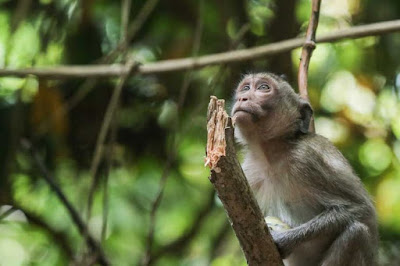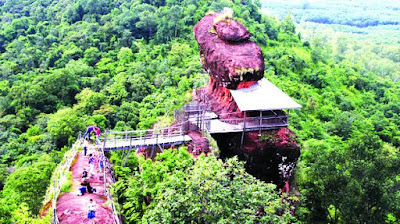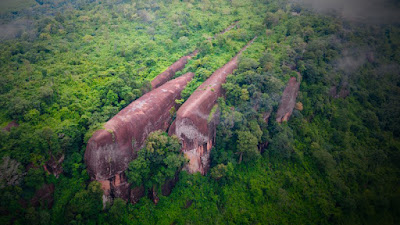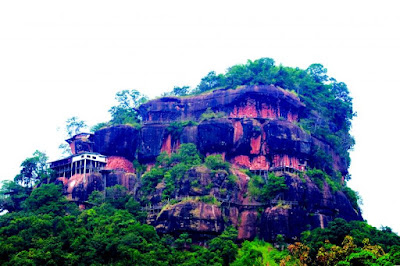Most tourists usually visit Kep province to stuff themselves with crabs, frolic on the shores of the beach and laze in the sun. But the Kingdom’s smallest province has one more gem to offer – the lush mountain ranges and tranquil atmosphere of the Kep National Park.
Unbeknownst to many, the Kep National Park, located behind the Veranda Natural Resort, offers an off-the-beaten track that’s waiting to be explored.
Established in 1993, the park covers an area of 66.65sq km and an 8km mountain trail circuit that’s easily travelled by foot, motorbike or mountain bike.
“Most of the local tourists are students who wish to see the great outdoors, away from all the stress in school. Foreign tourists come here irregularly.
“Sometimes, we see 30 people a day. Sometimes, no one comes. If it’s the rainy season, we usually won’t have any guests,” says a park ranger.
Wide enough to allow cars to pass through, the inclined trail around the mountain offers the ideal path for cycling, motorbike-riding and trekking. Signs had been put up to guide the riders and hikers.
Unbeknownst to many, the Kep National Park, located behind the Veranda Natural Resort, offers an off-the-beaten track that’s waiting to be explored.
Established in 1993, the park covers an area of 66.65sq km and an 8km mountain trail circuit that’s easily travelled by foot, motorbike or mountain bike.
“Most of the local tourists are students who wish to see the great outdoors, away from all the stress in school. Foreign tourists come here irregularly.
“Sometimes, we see 30 people a day. Sometimes, no one comes. If it’s the rainy season, we usually won’t have any guests,” says a park ranger.
Wide enough to allow cars to pass through, the inclined trail around the mountain offers the ideal path for cycling, motorbike-riding and trekking. Signs had been put up to guide the riders and hikers.
.
.
Pok Toeng, the director of the Provincial Department of Tourism, said “at the circuit trail, tourists can ride bicycles and motorbikes. The trail is 8km long, 300m wide, and covers a total of almost 9,000ha”.
“Some people walk on the trail while some go depeer into the jungle. There are also signs inside the forest to guide hikers. We helped install signs, maps and flyers for the tourists,” he says.
Lao Innarith, 38, a guide at the Kep trek says: “I usually start the trek with my clients at the other end of the trail and then we walk our way back to the starting point. The distance is about 5km, I think.
“If we start at a place under the forest shade, we can reach by sunlight. But if I start in the open space in the morning, my clients and I will end the trek at the cold forest.
“We have many tourists in Kep but numbers have slightly gone down these past two years, especially tourists from Western countries. We usually have two to three groups a week, with each group composed of one to 30 people.
“If it’s a small group, we usually travel on foot. Otherwise, we ride a bus. Normally we spend around two hours trekking.”
At the end of the trail, a panoramic view of Kampot’s Bokor mountains, nearby villages and the island of Koh Tral await.
“We stopped at the Kampot viewpoint, about 2km from the park entrance and then came back. We didn’t take the mountain trail circuit because it could take a long time,” say Anna and Simon, a French couple who braved an hour-long trek in the park.
“The Led Zep Cafe offered the best vantage point. It’s where you can sit and have a drink and get a good view of nature before exploring its forest,” they added.
The map for the trails is provided by Led Zep Cafe, the only one in the area. They were made by the cafe’s now-deceased French founder, Christian Debinut.
“Some people walk on the trail while some go depeer into the jungle. There are also signs inside the forest to guide hikers. We helped install signs, maps and flyers for the tourists,” he says.
Lao Innarith, 38, a guide at the Kep trek says: “I usually start the trek with my clients at the other end of the trail and then we walk our way back to the starting point. The distance is about 5km, I think.
“If we start at a place under the forest shade, we can reach by sunlight. But if I start in the open space in the morning, my clients and I will end the trek at the cold forest.
“We have many tourists in Kep but numbers have slightly gone down these past two years, especially tourists from Western countries. We usually have two to three groups a week, with each group composed of one to 30 people.
“If it’s a small group, we usually travel on foot. Otherwise, we ride a bus. Normally we spend around two hours trekking.”
At the end of the trail, a panoramic view of Kampot’s Bokor mountains, nearby villages and the island of Koh Tral await.
“We stopped at the Kampot viewpoint, about 2km from the park entrance and then came back. We didn’t take the mountain trail circuit because it could take a long time,” say Anna and Simon, a French couple who braved an hour-long trek in the park.
“The Led Zep Cafe offered the best vantage point. It’s where you can sit and have a drink and get a good view of nature before exploring its forest,” they added.
The map for the trails is provided by Led Zep Cafe, the only one in the area. They were made by the cafe’s now-deceased French founder, Christian Debinut.
“He started drawing the map in 2002. He drew every attraction, trailheads, and viewpoints that hikers can visit,” says Lang Anika, one of the owners of the cafe, who worked very closely with Debinut.
Aside from managing the cafe, both Anika and co-owner Srey Pao, often explore the deep recesses of the jungle to clean the trails and set more signs for tourists to follow.
Aside from managing the cafe, both Anika and co-owner Srey Pao, often explore the deep recesses of the jungle to clean the trails and set more signs for tourists to follow.
.
.
“Tourists walk here for leisure. But for us, we spend day and night in the forest to clean the area, pave a trail for them and renew the signs.
“We only do it in the forest trails and leave the circuit trail to the authorities since the road was widened to provide access to cars in 2018,” says Anika.
Cambodians, Anika says, do not usually hike in the deep jungle. Some 99 per cent of the time, it’s the foreign tourists who literally go the extra mile.
She says foreigners have picked up the habit of collecting their own trash from the forest, making it easier for her and Srey Pao to maintain its cleanliness.
Several of the noteworthy stops marked by Led Zep’s map are the Kampot Viewpoint, Sreytal Waterfall, Main Trail Summit, Angkoul beach viewpoint, Little Pond, Nun’s Pass, Sunset Rock, Kep Gardens, Little Buddha and Stone Horse.
The entrance to Kep National Park can be found behind Veranda Natural Resort, about 7.6km from the White Horse roundabout sculpture in the town of Kep.
“We only do it in the forest trails and leave the circuit trail to the authorities since the road was widened to provide access to cars in 2018,” says Anika.
Cambodians, Anika says, do not usually hike in the deep jungle. Some 99 per cent of the time, it’s the foreign tourists who literally go the extra mile.
She says foreigners have picked up the habit of collecting their own trash from the forest, making it easier for her and Srey Pao to maintain its cleanliness.
Several of the noteworthy stops marked by Led Zep’s map are the Kampot Viewpoint, Sreytal Waterfall, Main Trail Summit, Angkoul beach viewpoint, Little Pond, Nun’s Pass, Sunset Rock, Kep Gardens, Little Buddha and Stone Horse.
The entrance to Kep National Park can be found behind Veranda Natural Resort, about 7.6km from the White Horse roundabout sculpture in the town of Kep.
Source - Phnom Penh Post














